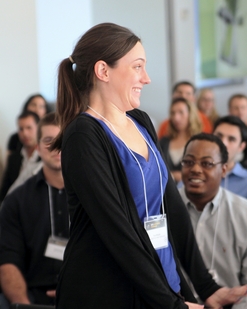
Engineering students among Innovation Challenge finalists

Posted: January 27, 2011

Tara Wright, biomedical engineering student in the Ira A. Fulton Schools of Engineering, stands for recognition as her team, BanglaEPICS Water Distribution Team, is announced as an Innovation Challenge finalist.
Eleven project teams that are among the finalists for Arizona State University’s Innovation Challenge are led by students in the Ira A. Fulton Schools of Engineering.
The competition gives students opportunities to win funding for entrepreneurial endeavors that focus on innovative ways to help communities on local or global scales – through new product development, business ventures or community service partnerships.
It’s designed to help students hone skills in teamwork, leadership, project development, business planning and public speaking.
This year 30 teams selected from more than 150 applicants have been chosen as finalists. The teams will present project proposals to a panel of judges on Feb. 15.
Winning teams could be presented grants ranging from $1,000 to $10,000.
Final teams led by Ira A. Fulton Schools of Engineering students are:
Reactive Mobile Cloud (RMC) RMC will assist football team doctors to immediately identify head injuries among athletes and drive the new technology to be developed for protecting the athletes more efficiently over the span of their career. Team leader: Eric Luster.
Multiplexed Diabetes Management Multiplexed Diabetes Management (MDM) is a transformative technology with long-term impact in diabetes care. Team leader: Aman Verma.
Augmented Innovations Augmented Innovations creates a novel computer interface for doctors to be able to access and interact with patient data technologies in sterile environments. Team leader: Arash Tadayon.
bioSPY bioSPY is developing a proof-of-concept in a sound business model based on a healthcare need for peptide-enhanced medical devices that confer the specificity required in the administration of personalized medicine. Team leader: Casey Hallberg.
Doc-in-a-Box Doc-in-a-Box is the solution to meet the need for mobile medical clinics in disaster areas, while at the same time recycling unused shipping containers. Team leader: John Walters.
BanglaEPICS Water Distribution Team BanglaEPICS Water Distribution Team is dedicated to finding sustainable water filtration and distribution solutions for a girl’s school in Bangladesh; this model will be put into practice, which may then be exported to other school and community sites. Team leader: Eric Lehnhardt.
Project LOCAL Project LOCAL is developing a facility out of a retired shipping container that provides a safe and clean place to give birth; the team is also collaborating with U.S.-based doctors to develop a training program for practicing African midwives to prevent deaths by hemorrhage, sepsis, obstructed labor and hypertensive diseases. Team leader: Susanna Young.
Team STRIDE Team STRIDE (Strides for Stephen) is an integrated effort to develop a mobility assistance device for Stephen Ogalo, who was crippled through a bicycle accident near his village in Kenya; his device must be made from sustainable materials and will allow him to maintain it with minimal resources. Team leader: Ben Teplitzky.
SP2 Energy SP2 Energy has developed a unique solar power generator and is collaborating with another Innovation Challenge applicant, Project LOCAL, to provide power for Project LOCAL’s container clinic. Team leader: Aaron Peshlakai.
Water Savers The Clarkdale Sustainability Park is developing a recreation park/tourism site by recharging waste water into the ground and reusing it. Team leader: Juana Grado.
Project Upepo Project Upepo seeks to focus sustainable technology to produce meaningful change by combining education, employment, and electrification, via wind technology. Team leaders: engineering student Kyle Karber and Emily Kempe, College of Public Programs.



































